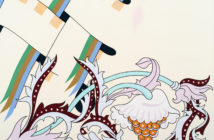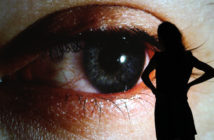The LINES Ballet’s Friday night performance at the Institute of Contemporary Art began with false informality: the dancers, wearing sweatpants and t-shirts, warmed up on stage as the sold out audience took their seats. Though this display was meant to be casual, it was still a performance. One female dancer stretched in loose pants and a hooded sweatshirt, but her pointe shoes emerged every time she lifted her legs in long arabesques, hinting at what was to come.
Choreographer Alonzo King knows how to create a visual tableau. King’s appropriately named LINES Ballet troupe has both the discipline for ballet and the energy for his melding of African dance and original quirky movements. Though at some points in the performance the blur of hyperkinetic movement became too much to take in, the show was nonetheless enchanting and, at times, even heart wrenching.
In the 15-year-old “Signs and Wonders” and the 2009-created “Dust and Light,” the audience was able to see the depth of King’s dance vocabulary but also his maturation. “Signs” was the weaker piece of the evening. This is not to say that the swooping lines, powerful leaps and turns that marked this piece were not jaw-dropping. They were, but anything compared to “Dust and Light” would pale by comparison. In this opening number, the dancers were at their greatest when they moved in duets or alone to the traditional African music. With the men wearing somewhat silly--see-through--black mesh shirts and velour-looking bottoms of various lengths and the four female dancers in a variety of leotard ensembles, they punctuated their routines with stretching upward reaches. Movement for the larger groups caused them to lose momentum, making off-angles and timing more apparent.
In spite the piece’s flaws in gracefulness, it was particularly intoxicating to watch the same pale ballerina who had merely hinted at her leg extension during the onstage warm-up. With one of her long arms raised towards the sky, her hand bent at the wrist, one of her legs would often be reaching out, pulling her body to its full length. What was she grasping for? And why did the choreography call for the dancers to leap and turn so quickly that at times the male dancers’ movement border on violent? It speaks much to the talent of Lines Ballet that they made such high-energy movement look effortless.
For “Dust and Light,” lighting designer Axel Morgenthaler bathed the dancers in a soft, hazy glow, giving an ethereal, otherworldly illusion to the performance. The piece began with a female dancer, clad in a mint-green leotard and skirt, crawling, on pointe, into a rectangle of light. The rest of the company soon joined her as Francis Poulenc and Arcangelo Corelli’s powerful “Agnus Dei” soared in the background.“Dust” became a series of duets, and like “Signs and Wonders” the choreography always returned to the creating of lines—the most important one being from the tip of the fingers to the tip of the toes. However, as couples caught, pushed, and wound themselves around each other, it was apparent how differently King’s signature movements would be used in this mature piece.
With power and restraint the dancers tightly moved together, yet remained divided. The duets seemed to be more about power, control, resistance and private loneliness than love. At one point a male dancer--clad in a Romanesque skirt, his chest bare--entered the upper stage as a male-female couple moved around each other at center stage. With his hands clutched to his heart, the skirt-clad dancer lowered himself to a crawl, becoming a prop for the female dancer to briefly stand on before leaping off again. A similar moment of indifference occurred when another female dancer launched herself over her male partner’s shoulder by climbing on his bent knee, standing briefly on his shoulder, and sliding down his back as if he wasn’t there at all.
“Dust and Light” is permeated with sadness, but it ended with hope as the company finally met as a whole on stage and dissolved in a frenzy of movement. So beautiful was this piece, exiting the theater afterward felt disorienting.
Boston should eagerly await the San Francisco-based Lines Ballet’s next tour of the East coast.
The Institute of Contemporary Arts
The "Alonzo King LINES Ballet" troupe performed at the ICA January 22-24, 2010.
All images are courtesy of the Alonzo King LINES Ballet troupe and World Music/Crash Arts.




